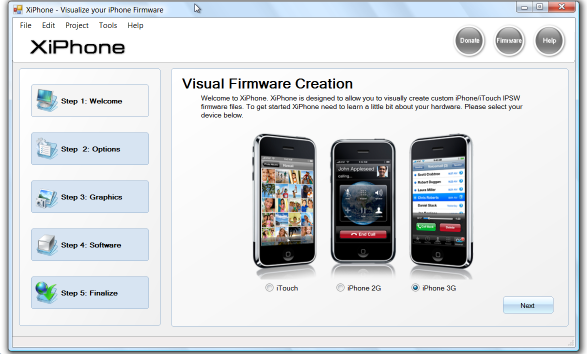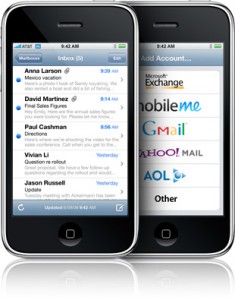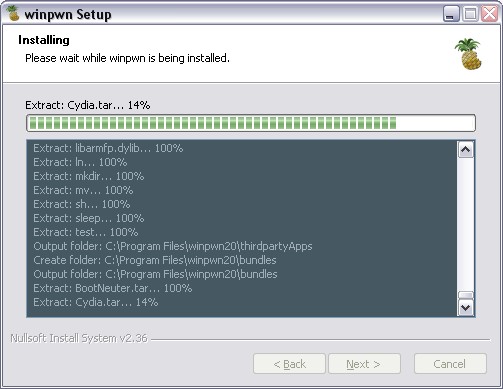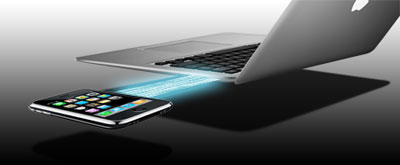News tagged ‘.NET’
QuickPwn and PwnageTool for 2.1 firmware
![]()
Dev Team released QuickPwn and PwnageTool for firmware 2.1 (, ). It doesn't work with new iPod yet. Mac OS versions only for now.
Direct Downloads - QuickPwn
Direct Downloads - PwnageTool
 Leave a comment, read comments [2]
Leave a comment, read comments [2]
XiPhone

Recently a new project has been started, called XiPhone. It will be based on XPWN. So functionality similar to WinPwn and Pwnage will be present (jailbreak, unlock, etc). In addition to that developers plan to include:
- Auto downloading of stock firmware files from apple’s site (no need to hunt for it then select it)
- Wizard based modern GUI (created with .net 2.0), and Vista Style UI.
- Export of firmware settings so users can pass around an XML file which contains a configuration that works for them.
- Auto updates to the XiPhone software.
- Community based wallpapers used for Bootscreen, Restore screen and others
- Enabling / Disabling of options available based on the device you select.
Unfortunately, only Windows platform users will be able to use XiPhone.
iPhone's firmware 2.0.2 is out

Apple just released new firmware for iPhone - version 2.0.2. As usual, all the company mentioned was that the update includes "Bug fixes."
Notes on the release follow:
- No new settings appear to have been included.
- Some users report faster browsing, though this may be due to cleared cache.
- Typing lag may be reduced.
- No consensus on improved 3G connectivity.
- iPod Touch firmware 2.0.2 also released.
But as always, do not update until we get word on a jailbreak.
Links for firmware downloads: , .
WinPwn 2.0.0.4 with support of 2.0.1 firmware
released just a day ago. And now WinPwn - iPhone jailbreaker and unlocker for windows is avaliable. The main new feature - it supports firmware 2.0.1.
Download 2.0.0.4: [] []
Download firmwares: iPhone , , , iPhone 3G ,
2.0.0.4 features:
- Support for both 1.1.4, 2.0, 2.0.1
- Root partition resize support
- Installer support
- Support for WinXP and Vista 32/64bit.
Notes are as usual:
- You MUST do a full uninstall of winpwn before installing the new version
- Make sure you have the latest version of iTunes (from 7.7)
- WinPwn uses 300MB of ram at peak due to the ipsw being extracted in memory
- You must first click browse and load an IPSW to use WinPwn (i thought this was clear)
- For 2.0 only the *5A347_Restore.ipsw files are valid. The 345 image will not work
- If you see Failed to load image catalog/payload catalog, this is fine and won’t cause problems
- If you already have service with AT&T do not activate or install Youtube Fix
- As usual jailbreak for iPhone and iPhone 3G, unlock only for iPhone.
- It is recommended to use at least 550mb partition size to accommodate a space issue that causes some folks errors such as “the ipsw failed to create”.
How to:
iPhone Тunnel Suite - SSH without WiFi

The easy way to connect to IPhone is thriugh SSH. But this method works when you have wifi. Now there is an application that allows to connect thriugh SSH without wifi, regular usb cable is used instead.
Step 1. Install OpenSSH on iPhone
Step 2. Download and install
Step 3. Download and install
Step 4. Run Tunnel Suite and select iPhone Tunnel, than select WinSCP or Putty. If you use Putty put 127.0.0.1 for Host Name.
 Leave a comment, read comments [1]
Leave a comment, read comments [1]
NES emulator 2.0.3
The new version of the popular for the iPhone and iPod touch now includes accelerometer control for all games. The implementation is very simple: A tilt is equivalent to controlling input in that direction. This means that tilt control can be used in any game loaded into the emulator, but also that some of the controls are pretty much balls. Also, this app does not live in the official app store. NES.app 2.3.0 with tilt control is available now in Cydia.
As seen in the video, controlling Mario is fairly natural, though quick turns and exact jumps are difficult to execute (playing Mario with the stock controls is often worse, though). Bomberman sort of works, but in that case—and many others—the old touch control overlay is much easier. Obviously none of these games were designed with tilt control in mind, but a surprising number are at least playable.
via gizmodo
Mail app crashing on 2.0? There is a solution.

Is your mail crashing on 2.0 firmware?
This is generally caused after syncing your backup. This has nothing to do with jailbreaking or not. However, the fix for it is simple and is part of a jailbreak. The issue is that after syncing your backup, your mail folder is owned by root and your mail app running as user mobile does not have permissions to access it. You can fix it in SSH. But I also added a button in BossPrefs to solve it.
Step 1:Jailbreak your device
Step 2: Install BossPrefs from Cydia
Step 3: Tap “more”
Step 4: Tap “Fix User Dir Permissions”
Step 5: Sometimes, not always, you will need to load settings and reenter your mail passwords.
via sleepers.net
WinPwn 2.0 released

You can download it from or .
Featues:
- Support for both 1.1.4 and 2.0
- Custom Image Support
- Custom Payload Support
- 3g iPhone support
How to:
- First create a custom IPSW using the IPSW Builder (original is ).
- Click "Ipwner" and browse for the custom IPSW that you just created. This will pwn itunes and allow you to flash
- Custom IPSW files via DFU mode
- Once you have pwned Itunes, put your phone into DFU mode. If you don't know how to do this click .
- Once you are in DFU mode Itunes will pop up and then you can hold shift and click restore and browse to your custom IPSW file.
Important Notes
Remove Winpwn 1.0 completely if you have it installed. Installing over the top of WinPwn 1.0 will cause problems.
Make sure you have the latest version of iTunes ( Currently 7.7)
If you already have service with AT&T do not activate or install Youtube Fix
UPDATE: there is a new version avaliable:
 Leave a comment, read comments [1]
Leave a comment, read comments [1]
Get internet on a desktop or notebook through IPhone 3G

Thanks to and the porting work of as well as the authors of , it is now possible to "tether" your iPhone 3G and use its Internet connection on your laptop.
Warning - Tethering your iPhone is against the iPhone data plan terms. AT&T could slap you with huge fees if you overuse this. I recommend only using it during emergencies.
Here is a basic plan (by the way, this should work for old IPhone also):
- Jailbreak your iPhone 3G
- Install 3Proxy and Terminal
- Create an ad-hoc Wi-fi network using your laptop
- Join the network with your iPhone
- Find the iPhone's IP address
- Open Terminal and run the proxy program
- Open Safari on your iPhone and open a web page
- Configure your browser to use the proxy
Later we'll discuss it with more details.
Step 1: Jailbreak your iPhone
 Leave a comment, read comments [3]
Leave a comment, read comments [3]
Safari benchmark - 2.0 is faster than 1.1.4
There is not much defference between Safari 1.1.4 and 2.0. But Under the hood, MobileSafari 2.0's performance is hugely improved over 1.1.4. Everything related to web surfing feels faster, web pages consistently load faster on 2.0, both via Wi-Fi and EDGE. This has nothing to do with the new iPhone 3G hardware — this is about dramatic performance improvements on original iPhones upgraded to the 2.0 OS.
Using MobileSafari simply feels faster, especially with web applications. Feel is by nature subjective, but JavaScript benchmarks back this up.
In August last year, to compare the iPhone's processing power and JavaScript interpreter against Safari 3 running on a Mac with a 1.83 GHz Core Duo. At that time, the current version of the iPhone OS was 1.0.1. Here are the results of those same benchmarks on original iPhones running the 1.1.4 and new 2.0 OS versions, with Hockenberry’s 1.0.1 results included for comparison:
| Test | 1.0.1 | 1.1.4 | 2.0 | Vs. 1.0.1 / 1.1.4 |
|---|---|---|---|---|
| 100,000 iterations | 3.209 | 1.096 | 0.145 | 22× / 8× |
| 10,000 divisions | 0.413 | 0.181 | 0.029 | 14× / 6× |
| 10,000 sin(x) calls | 0.709 | 0.373 | 0.140 | 5× / 3× |
| 10,000 string allocations | 0.777 | 0.434 | 0.133 | 6× / 3× |
| 10,000 function calls | 0.904 | 0.595 | 0.115 | 8× / 5× |
The last column shows how many times faster the 2.0 version of MobileSafari was versus 1.0.1 and 1.1.4. The same results, charted (smaller bars are faster) can be viewed above.
The results are obvious. WebKit JavaScript performance has improved steadily and significantly in just one year, with a huge jump between 1.1.4 and the new 2.0.0. In side-by-side page loading tests between two original iPhones running 1.1.4 and 2.0.0, the new version consistently finished at least a few seconds faster.
For all the hubbub regarding the new App Store, most “iPhone software” runs in the web browser. But improvements in WebKit performance often help native iPhone app performance, too — a slew of my favorite native iPhone apps have built-in WebKit browsers (e.g., NetNewsWire, Twitterrific, Instapaper, and Cocktails). When WebKit performance improves, any app that uses WebKit improves, and WebKit improved a lot between iPhone 1.1.4 and 2.0.0.
via daringfireball.net
iRinger - create your own ringtone (free)
iRinger creates free ringtones for your iPhone from virtually any music or video file you own. Even YouTube videos! iRinger exports ringtones to iTunes, so there is no need to "jailbreak" your iPhone. You will be creating ringtones in seconds. It's that simple. Here is a video tutorial:
Feature:
- FREE
- Three Steps: Import, Preview then Export. Done.
- Convert virtually any audio format into an iPhone ringtone
- Extracts audio out of video
- Choose which section of the audio you want to hear
- Adjust ringtone length, volume, fade in, fade out and loop gap
- Export to iPhone ringtone format and import right into iTunes
- Export to iPhone using SCP/SFTP and skip using iTunes
- Use audio effects: Delay, Flanger, Boost, Reverse, etc.
- Runs on all versions of Microsoft Windows including Windows Vista
- Requires iPhone firmware 1.1.2 or newer, iTunes software 7.5 or newer
- Works with the new iPhone 3G!
Download here: . Developer's site:
Here is an advanced video tutorial, it shows how to use some advanced features:
Java VM for IPhone
JamVM is a new Java Virtual Machine which conforms to the JVM specification version 2 (blue book). In comparison to most other VM's (free and commercial) it is extremely small, with a stripped executable on PowerPC of only ~200K, and Intel 180K. However, unlike other small VMs (e.g. KVM) it is designed to support the full specification, and includes support for object finalisation, Soft/Weak/Phantom References, class-unloading, the Java Native Interface (JNI) and the Reflection API.JamVM currently only includes an interpreter (keeps it small). However, the interpreter is highly optimised, and performance is on par with a simple JIT. As most of the code is written in C it is easy to port to new architectures.
How to Port phoneME Advanced Software to iPhone

The objective of the phoneME project is to further expand the usage of Java™ Platform, Micro Edition (Java ME platform) technology in the mobile handset market. The goal in making these technologies available to the Mobile & Embedded Community is to reduce implementation variation, increase the rate of innovation and enable new devices to leverage the power of the Java ME platform.
During 2008 conference at San Francisco senior staff engineer Hinkmond Wong (Java Micro Edition group at Sun Microsystems) will speak about porting phoneME Advanced Software to different mobile platporms, including IPhone:
Session Title: "How to Port phoneME™ Advanced Software to Google Android, iPhone, OpenMoko, LiMO, and More".
Session Abstract: "This presentation discusses how to port phoneME™ Advanced open source mobile platform software to the latest hot cell phone and embedded device environments such as Google-OHA, Android SDK, iPhone/iPod (touch) SDK, OpenMoko, and LiMO.
The objective of the phoneME project is to further expand the use of the Java™ Platform, Micro Edition (Java ME platform) in the mobile handset market through open source. The project scope includes a focus on the emerging next-generation phone segment with the phoneME Advanced software stack. This session concentrates on how to use the open-source phoneME Advanced project as the core Java virtual machine and libraries to enable the most-recent popular mobile development platforms to become Java technology-enabled. "
Make sure to attend this event and this sesson in particular. Hinkmond Wong is an expert from Sun Microsystems, who can answer many questions about IPhone, Java and more.
 Leave a comment, read comments [4]
Leave a comment, read comments [4]